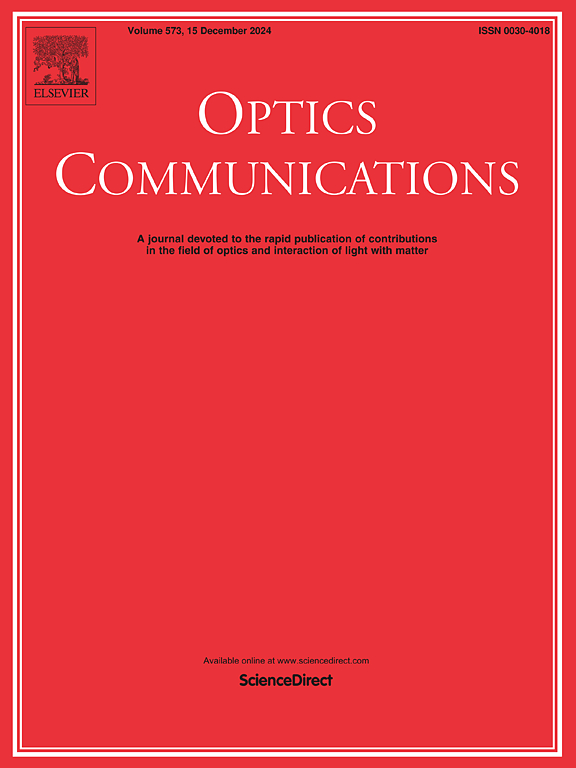Sensing using heralded single photons: An application towards ultra-sensitive temperature measurement
IF 2.2
3区 物理与天体物理
Q2 OPTICS
引用次数: 0
Abstract
A novel ultra-sensitive temperature sensor utilizing Heralded Single Photons (HSPs) is proposed and experimentally verified in this investigation. HSPs are crucial in various quantum technologies. The utilization of a heralded single-photon (HSP), as opposed to a classical light source, enables superior sensitivity in quantum sensing applications. This investigation focuses on the successful generating HSPs to design a highly sensitive quantum optical temperature sensor. The HSPs were produced from a PPKTP nonlinear crystal using the spontaneous parametric down-conversion process (SPDC) under the quasi-phase matching (QPM) condition. The signal and idler photons resulting from this process were transmitted through two different identical optical fibers and then to two identical single-photon detectors. The temporal properties of these photons were analyzed using a coincidence counter. A portion of the fiber carrying the signal was decladded to serve as the sensor probe. The sensor was calibrated by measuring the average transmittance with varying temperatures near the sensor probe. The sensing principle is explained deriving an expression for average transmittance as a function of temperature. The measurement error surpassed the Standard Quantum Limit (SQL), improving measurement sensitivity. The resolution and sensitivity of the developed quantum sensor were shown to be 0.0925 °C and 0.00677 /°C respectively. This study emphasizes the potential for enhancing sensitivity and minimizing shot noise with the use of HSPs. The merits of the proposed sensor, over the other quantum senor is its less complex design and low decoherence.
使用预示的单光子传感:在超灵敏温度测量中的应用
提出了一种新型的超灵敏单光子温度传感器,并进行了实验验证。热敏感蛋白在各种量子技术中都是至关重要的。与传统光源相比,利用预示单光子(HSP)可以在量子传感应用中实现更高的灵敏度。本研究的重点是成功地产生热激光蛋白来设计高灵敏度的量子光学温度传感器。在准相位匹配(QPM)条件下,利用PPKTP非线性晶体的自发参数下转换过程(SPDC)制备了热致发光晶体(HSPs)。该过程产生的信号和空闲光子通过两根不同的相同光纤传输,然后传输到两个相同的单光子探测器。利用巧合计数器分析了这些光子的时间特性。携带信号的光纤的一部分被去掉作为传感器探针。通过测量传感器探头附近不同温度下的平均透射率来校准传感器。推导出平均透过率随温度的函数表达式,解释了传感原理。测量误差超过标准量子极限(SQL),提高了测量灵敏度。所研制的量子传感器的分辨率和灵敏度分别为0.0925°C和0.00677°C。本研究强调了使用热敏感蛋白提高灵敏度和减少射击噪声的潜力。与其他量子传感器相比,该传感器的优点是设计简单,退相干性低。
本文章由计算机程序翻译,如有差异,请以英文原文为准。
求助全文
约1分钟内获得全文
求助全文
来源期刊

Optics Communications
物理-光学
CiteScore
5.10
自引率
8.30%
发文量
681
审稿时长
38 days
期刊介绍:
Optics Communications invites original and timely contributions containing new results in various fields of optics and photonics. The journal considers theoretical and experimental research in areas ranging from the fundamental properties of light to technological applications. Topics covered include classical and quantum optics, optical physics and light-matter interactions, lasers, imaging, guided-wave optics and optical information processing. Manuscripts should offer clear evidence of novelty and significance. Papers concentrating on mathematical and computational issues, with limited connection to optics, are not suitable for publication in the Journal. Similarly, small technical advances, or papers concerned only with engineering applications or issues of materials science fall outside the journal scope.
 求助内容:
求助内容: 应助结果提醒方式:
应助结果提醒方式:


